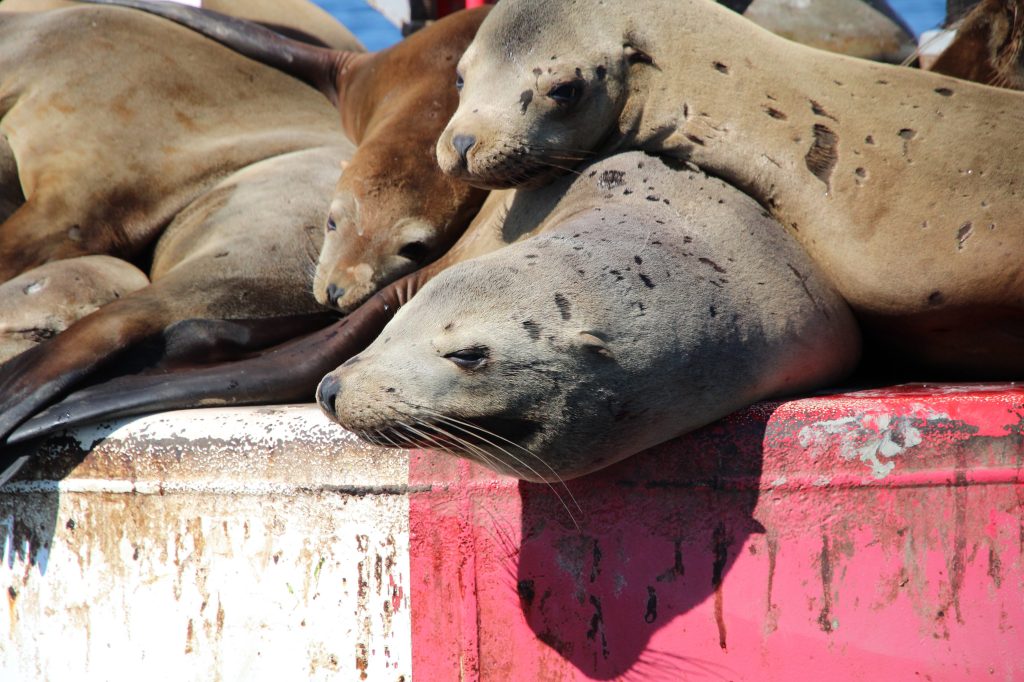
Gleaming under the sun, balancing on buoys, and captivating visitors along California’s coastline, the California sea lion (Zalophus californianus) is a familiar and beloved marine mammal. Known for their intelligence, playfulness, and agility, they are a symbol of the Golden State’s rich coastal biodiversity. Despite occasional years of periodic starvation and decline, the California sea lion has made a remarkable recovery over the last two decades and is now one of the most common marine mammals to be seen along the California coast.
California sea lions are part of the family Otariidae, which includes all eared seals. These agile marine mammals are well adapted for life in the ocean, with streamlined bodies, strong flippers, and a layer of blubber to help regulate body temperature. Male sea lions are larger than females, weighing up to 800 pounds (363 kg) and measuring around 8 feet (2.4 meters) in length. Females are slightly smaller, weighing around 250 pounds (113 kg) and measuring about 6 feet (1.8 meters) long. Although many people refer to them as seals, they are a different species, and it is fairly easy to tell them apart. Unlike true seals, sea lions have visible ear flaps and long front flippers that enable them to “walk” on land.

Ranging from the Gulf of California to British Columbia, these marine mammals are a frequent sight around harbors, beaches, and offshore islands. These highly social creatures also congregate in large colonies on rocky shores, such as the Channel Islands off the coast of Southern California. During breeding season, males establish territories and compete fiercely for females, often engaging in vocal displays and physical battles. The females give birth to a single pup each year and provide maternal care for several months until the pup is ready to venture into the water.

California sea lions are opportunistic feeders, primarily preying on fish species such as anchovies, herring, salmon, and squid. With their excellent underwater vision and agile swimming abilities, they can dive to great depths, sometimes reaching over 900 feet (275 meters) to search for their prey. They are capable of consuming significant amounts of food, with adult males consuming up to 5-8% of their body weight each day.

Despite their formidable size and agility, California sea lions face predation from their most notorious adversary, the white shark (Carcharodon carcharias). White sharks are highly efficient hunters and occasionally target sea lions, particularly the young as well as inexperienced individuals. While these encounters are relatively rare, they underscore the ongoing struggle for survival that sea lions face in their natural habitat. Because of the resurgence in the sea lion population on the West Coast, white shark populations have also rebounded significantly, with a recent study suggesting that there can be as many as 40 juvenile white sharks just 50 feet from shore at some of the most popular beaches in SoCal. While this rise in the white shark population off California has made many people concerned about the potential for attacks on humans, records show that just 15 people have died by shark attacks in California since the 1950s.
The California sea lion population has experienced both remarkable recoveries and challenging times. In the early 20th century, they faced severe exploitation for their fur, resulting in significant declines in their numbers. However, conservation efforts and legal protection brought about a remarkable turnaround for these marine mammals.
Under the Marine Mammal Protection Act and state regulations, California sea lions are strictly protected, prohibiting hunting and harassment. Additionally, the establishment of marine protected areas and efforts to reduce pollution and fishery interactions have contributed to their recovery. As a result, the population rebounded, with estimates suggesting that there are now around 300,000 individuals along the coast of California.

Despite their resurgence, California sea lions face ongoing challenges, particularly during certain years when large-scale die-offs occur due to starvation. These events are often linked to El Niño weather patterns, which disrupt the marine ecosystem and cause shifts in fish populations. During such periods, the availability of prey may be limited, leading to malnutrition and high mortality rates among sea lion pups.
While California sea lions have made a remarkable recovery, ongoing conservation efforts are crucial to ensuring their long-term survival. Monitoring their populations, protecting their habitats, and addressing climate change impacts are vital steps to safeguarding these charismatic marine mammals. By raising awareness and promoting responsible stewardship of our coastal ecosystems, we can ensure a bright future for the California sea lion and the diverse marine life it represents.

The California sea lion is more than just a beautiful creature; it is a complex organism with intriguing behaviors, eating and mating habits, and an intrinsic part of the marine ecosystem. Their playful antics, struggles for survival, and successful recovery offer a profound connection to the ocean and a reminder of our shared responsibility in preserving its richness and diversity. Their presence along California’s shores is a testament to what concerted conservation efforts can achieve, and a symbol of the Golden State’s vibrant coastal culture and identity.